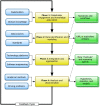Chapter 1: Biomedical knowledge integration
- PMID: 23300416
- PMCID: PMC3531314
- DOI: 10.1371/journal.pcbi.1002826
Chapter 1: Biomedical knowledge integration
Abstract
The modern biomedical research and healthcare delivery domains have seen an unparalleled increase in the rate of innovation and novel technologies over the past several decades. Catalyzed by paradigm-shifting public and private programs focusing upon the formation and delivery of genomic and personalized medicine, the need for high-throughput and integrative approaches to the collection, management, and analysis of heterogeneous data sets has become imperative. This need is particularly pressing in the translational bioinformatics domain, where many fundamental research questions require the integration of large scale, multi-dimensional clinical phenotype and bio-molecular data sets. Modern biomedical informatics theory and practice has demonstrated the distinct benefits associated with the use of knowledge-based systems in such contexts. A knowledge-based system can be defined as an intelligent agent that employs a computationally tractable knowledge base or repository in order to reason upon data in a targeted domain and reproduce expert performance relative to such reasoning operations. The ultimate goal of the design and use of such agents is to increase the reproducibility, scalability, and accessibility of complex reasoning tasks. Examples of the application of knowledge-based systems in biomedicine span a broad spectrum, from the execution of clinical decision support, to epidemiologic surveillance of public data sets for the purposes of detecting emerging infectious diseases, to the discovery of novel hypotheses in large-scale research data sets. In this chapter, we will review the basic theoretical frameworks that define core knowledge types and reasoning operations with particular emphasis on the applicability of such conceptual models within the biomedical domain, and then go on to introduce a number of prototypical data integration requirements and patterns relevant to the conduct of translational bioinformatics that can be addressed via the design and use of knowledge-based systems.
Conflict of interest statement
The author has declared that no competing interests exist.
Figures




Similar articles
-
Tuberculosis.In: Holmes KK, Bertozzi S, Bloom BR, Jha P, editors. Major Infectious Diseases. 3rd edition. Washington (DC): The International Bank for Reconstruction and Development / The World Bank; 2017 Nov 3. Chapter 11. In: Holmes KK, Bertozzi S, Bloom BR, Jha P, editors. Major Infectious Diseases. 3rd edition. Washington (DC): The International Bank for Reconstruction and Development / The World Bank; 2017 Nov 3. Chapter 11. PMID: 30212088 Free Books & Documents. Review.
-
Systems Biology Applications to Decipher Mechanisms and Novel Biomarkers in CNS Trauma.In: Kobeissy FH, editor. Brain Neurotrauma: Molecular, Neuropsychological, and Rehabilitation Aspects. Boca Raton (FL): CRC Press/Taylor & Francis; 2015. Chapter 30. In: Kobeissy FH, editor. Brain Neurotrauma: Molecular, Neuropsychological, and Rehabilitation Aspects. Boca Raton (FL): CRC Press/Taylor & Francis; 2015. Chapter 30. PMID: 26269919 Free Books & Documents. Review.
-
Translational Metabolomics of Head Injury: Exploring Dysfunctional Cerebral Metabolism with Ex Vivo NMR Spectroscopy-Based Metabolite Quantification.In: Kobeissy FH, editor. Brain Neurotrauma: Molecular, Neuropsychological, and Rehabilitation Aspects. Boca Raton (FL): CRC Press/Taylor & Francis; 2015. Chapter 25. In: Kobeissy FH, editor. Brain Neurotrauma: Molecular, Neuropsychological, and Rehabilitation Aspects. Boca Raton (FL): CRC Press/Taylor & Francis; 2015. Chapter 25. PMID: 26269925 Free Books & Documents. Review.
-
The future of Cochrane Neonatal.Early Hum Dev. 2020 Nov;150:105191. doi: 10.1016/j.earlhumdev.2020.105191. Epub 2020 Sep 12. Early Hum Dev. 2020. PMID: 33036834
-
Translational informatics: enabling high-throughput research paradigms.Physiol Genomics. 2009 Nov 6;39(3):131-40. doi: 10.1152/physiolgenomics.00050.2009. Epub 2009 Sep 8. Physiol Genomics. 2009. PMID: 19737991 Free PMC article. Review.
Cited by
-
Big data analytics in immunology: a knowledge-based approach.Biomed Res Int. 2014;2014:437987. doi: 10.1155/2014/437987. Epub 2014 Jun 22. Biomed Res Int. 2014. PMID: 25045677 Free PMC article.
-
MinePath: Mining for Phenotype Differential Sub-paths in Molecular Pathways.PLoS Comput Biol. 2016 Nov 10;12(11):e1005187. doi: 10.1371/journal.pcbi.1005187. eCollection 2016 Nov. PLoS Comput Biol. 2016. PMID: 27832067 Free PMC article.
-
Precision medicine review: rare driver mutations and their biophysical classification.Biophys Rev. 2019 Feb;11(1):5-19. doi: 10.1007/s12551-018-0496-2. Epub 2019 Jan 4. Biophys Rev. 2019. PMID: 30610579 Free PMC article. Review.
-
Review: Precision medicine and driver mutations: Computational methods, functional assays and conformational principles for interpreting cancer drivers.PLoS Comput Biol. 2019 Mar 28;15(3):e1006658. doi: 10.1371/journal.pcbi.1006658. eCollection 2019 Mar. PLoS Comput Biol. 2019. PMID: 30921324 Free PMC article. Review.
-
The structural basis for cancer treatment decisions.Oncotarget. 2014 Sep 15;5(17):7285-302. doi: 10.18632/oncotarget.2439. Oncotarget. 2014. PMID: 25277176 Free PMC article. Review.
References
-
- Coopers PW (2008) Research rewired. 48 p.
-
- Casey K, Elwell K, Friedman J, Gibbons D, Goggin M, et al... (2008) A broken pipeline? Flat funding of the NIH puts a generation of science at risk. 24 p.
-
- Payne PR, Johnson SB, Starren JB, Tilson HH, Dowdy D (2005) Breaking the translational barriers: the value of integrating biomedical informatics and translational research. J Investig Med 53: 192–200. - PubMed
-
- Research NDsPoC (1997) NIH director's panel on clinical research report. Bethesda, MD: National Institutes of Health.
-
- Sung NS, Crowley WF Jr, Genel M, Salber P, Sandy L, et al. (2003) Central challenges facing the national clinical research enterprise. JAMA 289: 1278–1287. - PubMed
MeSH terms
Grants and funding
LinkOut - more resources
Full Text Sources
Miscellaneous

